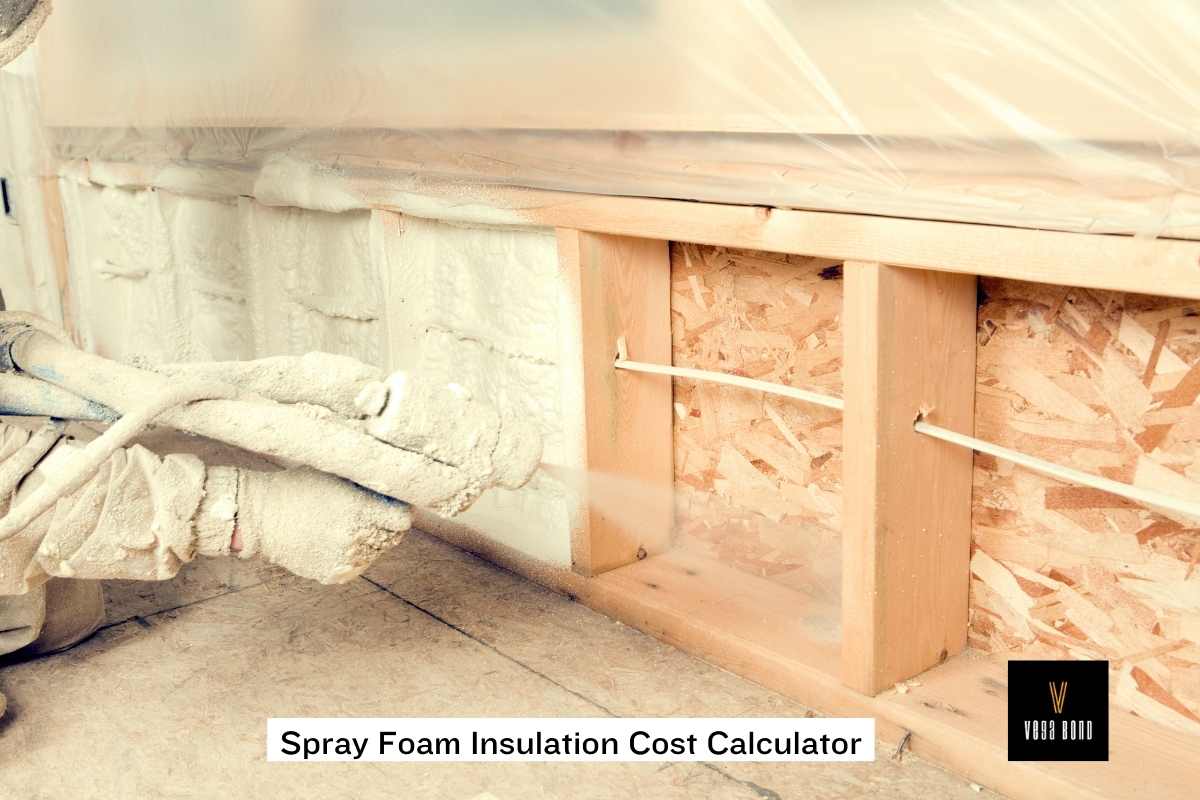Spray Foam Insulation Cost Calculator: Planning Your Budget
Ever wondered how much it costs to insulate your home with spray foam? A spray foam insulation cost calculator can help. It's perfect for those worried about their budget or just curious about the costs. This tool gives clear and precise estimates.
The spray foam insulation cost estimator makes planning easier. It looks at the area size, foam type, and cost per square foot. This allows you to calculate the cost accurately, ensuring you make smart budgeting choices before starting.
Key Takeaways
- A spray foam insulation cost estimator helps homeowners forecast insulation expenses.
- It takes into account key variables like area size, spray foam type, and cost per square foot.
- This tool is user-friendly and aids in planning and budgeting.
- By using an insulation cost per square foot calculator, you can avoid unexpected costs.
- Accurate estimates help in making informed decisions about home insulation needs.
Understanding Spray Foam Insulation
Spray foam insulation is a top pick for homeowners wanting to save on energy and costs. It's important to know what spray foam insulation is, what its benefits are, and what types of insulation there are. This will give you a full picture of this modern insulation solution.
What is Spray Foam Insulation?
Spray foam insulation is made from polyurethane or isocyanate and polyol resin. When mixed, it expands and hardens. It's sprayed on to fill gaps and crevices well. Unlike fiberglass or cellulose, it seals air leaks tightly, making it a top insulator.
Benefits of Spray Foam Insulation
Spray foam insulation has many advantages. It cuts down on energy use by sealing air leaks, which lowers heating and cooling bills. It also strengthens walls and roofs, making them more solid. Plus, it blocks noise, keeps moisture out, and prevents mold and mildew.
Types of Spray Foam Insulation
There are two main kinds of spray foam insulation: open-cell and closed-cell. Open-cell foam is light and spongy, great for inside walls and tight spots. It's cheaper but insulates less than closed-cell foam. Closed-cell spray foam is denser and more rigid, offering better insulation and a strong moisture barrier. It's best for outside use and damp areas.
Knowing the differences between spray foam insulation types helps homeowners choose wisely. Each type has its benefits, making sure there's a good match for every insulation need.
Factors Affecting Spray Foam Insulation Costs
The cost of spray foam insulation depends on several factors. Knowing these can help homeowners and businesses make better choices. For guidance, they can use a spray foam pricing calculator.
Material Costs
Material costs are a big part of the total cost. The type of foam used, open-cell or closed-cell, affects the price. Open-cell foam is cheaper but might not insulate as well as closed-cell foam. A foam insulation price calculator can help estimate costs accurately.
Installation Costs
Remember installation costs. These include labor, project complexity, and equipment needed. Skilled workers may charge more, especially for hard-to-reach areas. A spray foam cost estimator can help you understand labor costs.
Area of Installation
The size of the area being insulated affects the price. You need to calculate the cost of spray foam insulation per square foot for a total estimate. Bigger areas mean more material and labor, raising the cost. The difficulty of accessing the area can also increase costs.
Understanding these factors helps with accurate budgeting. Tools like a spray foam pricing calculator or a foam insulation price calculator are useful. They help plan your insulation project and manage resources well.
How to Use a Spray Foam Insulation Cost Calculator
Using a spray foam insulation cost calculator is a great way to plan your insulation project. We'll walk you through each step, explain the important inputs, and show you how to understand the results.
Step-by-Step Guide
- Access a reliable spray foam insulation estimate tool online.
- Enter the required information, including the square footage of the area to be insulated.
- Select the type of spray foam insulation you plan to use (open-cell or closed-cell).
- Input any additional factors affecting the project complexity, such as the number of windows or unique architectural features.
- Click 'Calculate' to receive your estimated costs.
Input Parameters
It's important to know the input parameters for accurate results with a spray foam insulation estimate tool. Key inputs include:
- Square Footage: The total area that needs insulation.
- Type of Foam: Choose between open-cell and closed-cell spray foam.
- Project Complexity: Factors like high ceilings, many windows, or hard-to-reach spots matter.
Interpreting the Results
The spray foam insulation cost calculator gives you detailed cost breakdowns. Here's what to look for:
- Material Costs: This covers the cost of the spray foam itself.
- Labor Costs: See how much installation will increase your total cost.
- Total Project Cost: This total gives you a clear budget for your insulation project.
Comparing Costs: Spray Foam Insulation vs. Alternatives
When looking at insulation options, it's key to look at both costs and how well they work. Let's explore the cost difference between spray foam and other insulation types like fiberglass and cellulose. This will help you see which one is more cost-effective and beneficial.
Spray Foam vs. Fiberglass
The cost of spray foam insulation versus fiberglass can be quite different. Fiberglass is usually cheaper at first, but spray foam is more energy efficient and has a higher R-value. This means it saves money over time. Here's a closer look at the two:
| Feature | Spray Foam | Fiberglass |
|---|---|---|
| Initial Cost | Higher | Lower |
| R-value per inch | 6-7 | 2.2-2.7 |
| Lifespan | 20+ years | 10-15 years |
| Energy Efficiency | Excellent | Moderate |
| Installation | Professional | DIY/professional |
Spray Foam vs. Cellulose
When comparing cellulose insulation to spray foam, there are many factors to consider. Cellulose is good for the environment and cheaper at first, but spray foam is better at sealing air and controlling moisture. Here's a detailed look at the two:
| Feature | Spray Foam | Cellulose |
|---|---|---|
| Initial Cost | Higher | Lower |
| R-value per inch | 6-7 | 3.6-3.8 |
| Lifespan | 20+ years | 20+ years |
| Energy Efficiency | Excellent | Good |
| Installation | Professional | Professional |
By comparing these options, you can make a smart choice about the best insulation for your needs. Consider the upfront costs versus the long-term savings and energy efficiency of spray foam insulation.
Top Online Spray Foam Insulation Cost Calculators
Planning your insulation project? It's key to have a reliable tool for estimating costs. Luckily, many online calculators are here to help. We'll explore what makes a good calculator.
Features to Look For
Choosing the right spray foam insulation cost estimator means looking at certain key features. These include:
- Customizable options for different insulation types
- Detailed breakdowns of labor and material costs
- User-friendly interface with intuitive input parameters
- Ability to save and revisit previous estimates
- Comprehensive geographical cost adjustments
These features help give you a precise and personalized estimate. They take into account your project's details and local costs.
Real-World Case Studies
Case studies of spray foam insulation show how it helps both homes and businesses. These examples show big energy savings and better comfort. They also give tips on keeping costs down for home projects and understanding savings for businesses.
Residential Applications
A family in Los Angeles made their 2,000-square-foot home more energy-efficient with spray foam insulation. They cut their energy bills by 30% in the first year. Knowing how to manage costs helped them get rebates from their utility company. This shows how smart planning can lead to big savings over time.
Commercial Applications
A 10,000-square-foot office in New York also benefited from spray foam insulation. The owners saved 25% on their monthly bills, adding up to thousands of dollars a year. These examples prove that looking at long-term savings is key when choosing insulation.
Cost-Saving Tips
Here are some ways to save money with spray foam insulation:
- Take Advantage of Utility Rebates: Many cities and states offer rebates for installing energy-efficient insulation.
- Consult Professionals: Engage experienced contractors who can advise on the best techniques and materials for your project.
- Think Long-Term: When evaluating residential spray foam application costs, factor in long-term energy cost reductions and maintenance savings.
Conclusion
In wrapping up our discussion on spray foam insulation, it's clear that an affordable spray foam insulation cost calculator is very useful. It helps homeowners and commercial property owners plan their budgets, making sure their budget matches their insulation needs.
You've learned about the different types of spray foam insulation and how it compares to other materials like fiberglass and cellulose. This gives you the knowledge to make a smart choice. Also, knowing how to use cost calculators is key to a successful insulation project.
Using these resources helps you get a better idea of the cost of spray foam, which makes financial planning easier. To get the best results, consider getting professional advice. This can give you more clarity and help you make the most of your insulation investment. With the right steps, you can pick options that save money and make your space more energy-efficient and comfortable.
FAQ
What is a spray foam insulation cost calculator?
A spray foam insulation cost calculator helps homeowners estimate the cost of insuring their homes with spray foam. You enter details like the area size, foam type, and cost per square foot, and the calculator gives you a cost estimate.
How do I use a spray foam insulation cost estimator?
To use a spray foam insulation cost estimator, you enter information like the area size, foam type, and project complexity. The estimator then gives you an estimate of the costs for materials and labor.
What are the benefits of spray foam insulation?
Spray foam insulation boosts energy efficiency, strengthens structures, reduces noise, and acts as a moisture barrier. It keeps indoor temperatures steady and seals gaps and cracks well.
What factors affect the cost of spray foam insulation?
The cost of spray foam insulation depends on material costs (like open-cell vs. closed-cell foam), installation costs (labor and project difficulty), and the size and accessibility of the area.
How does spray foam insulation compare to fiberglass?
Spray foam insulation is more energy-efficient and has a higher R-value than fiberglass. It might cost more upfront, but it can save money over time with energy savings and a longer lifespan.
Can I use a DIY spray foam insulation kit to save money?
Yes, DIY spray foam insulation kits are available for smaller projects and can be cheaper. But for bigger areas, it's best to hire professionals for proper application and the best results.
What are the types of spray foam insulation?
Spray foam insulation comes in two types: open-cell and closed-cell. Open-cell foam is lighter and more flexible, which is great for inside use. Closed-cell foam is denser, better at keeping moisture out, has a higher R-value, and is good for both inside and outside.
What should I consider when selecting a spray foam insulation cost calculator?
When picking a cost calculator, look for options for different insulation types, detailed estimates, and customization. A good calculator should give accurate results to help you plan your budget well.
How can I save money on spray foam insulation?
Save money by looking for rebates and discounts and getting quotes from several contractors. Also, think about the long-term energy savings when looking at upfront costs.



